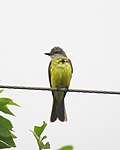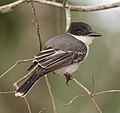

| Kingbirds | |
|---|---|

| |
| Eastern kingbird (Tyrannus tyrannus) | |
| Scientific classification | |
| Domain: | Eukaryota |
| Kingdom: | Animalia |
| Phylum: | Chordata |
| Class: | Aves |
| Order: | Passeriformes |
| Family: | Tyrannidae |
| Genus: | Tyrannus Lacépède, 1799 |
| Type species | |
| Lanius tyrannus | |
| Species | |
|
See text. | |
Tyrannus is a genus of small passerine birds in the tyrant flycatcher family Tyrannidae that are native to the Americas. The majority are named as kingbirds.
They prefer semi-open or open areas. These birds wait on an exposed perch and then catch insects in flight.[1] They have long pointed wings and large broad bills. These birds tend to defend their breeding territories aggressively, often chasing away much larger birds. A kingbird was photographed in 2009 defending its young by landing on and sinking its talons into the back of a red-tailed hawk and pecking its skull until the red-tailed hawk gave up and flew away.[2]
The genus was introduced in 1799 by the French naturalist Bernard Germain de Lacépède with the eastern kingbird (Tyrannus tyrannus) as the type species.[3] The genus name is the Latin word for 'tyrant'.[4]
The genus contains 13 species:[5]
| Image | Common Name | Scientific name | Distribution |
|---|---|---|---|
 |
Snowy-throated kingbird | Tyrannus niveigularis | Colombia, Ecuador, and Peru |
 |
White-throated kingbird | Tyrannus albogularis | Bolivia, Brazil, Colombia, Ecuador, Peru, and Venezuela, and in the Guianas of Guyana, Suriname and French Guiana |
 |
Tropical kingbird | Tyrannus melancholicus | Southern Arizona and the lower Rio Grande Valley of Texas in the United States through Central America, South America as far south as central Argentina and western Peru, and on Trinidad and Tobago |
 |
Couch's kingbird | Tyrannus couchii | Central and southern Texas along the Gulf Coast to the Yucatán Peninsula in Mexico, Belize and northern Guatemala. |
 |
Cassin's kingbird | Tyrannus vociferans | California and from Montana to Utah, along the eastern Rocky Mountains, and northern Central America |
 |
Thick-billed kingbird | Tyrannus crassirostris | Southeastern Arizona and extreme southwestern New Mexico in the United States and northern Sonora (the Madrean sky islands) through the western and western-coastal ranges in Mexico, south to western Guatemala. |
 |
Western kingbird | Tyrannus verticalis | Western half of the United States and the Pacific coast of southern Mexico and Central America. |
 |
Scissor-tailed flycatcher | Tyrannus forficatus | United States, in Texas, Oklahoma, Kansas, western portions of Louisiana, Arkansas, and Missouri, and far eastern New Mexico; northeastern Mexico |
 |
Fork-tailed flycatcher | Tyrannus savana | Central Mexico to central Argentina |
 |
Eastern kingbird | Tyrannus tyrannus | Open areas across North America |
 |
Gray kingbird | Tyrannus dominicensis | United States (mainly in Florida), through Central America and the Caribbean (from Cuba to Puerto Rico as well as eastward towards all across the Lesser West Indies), south to Venezuela, Trinidad and Tobago, the Guianas, and Colombia. |
 |
Giant kingbird | Tyrannus cubensis | Cuba |
 |
Loggerhead kingbird | Tyrannus caudifasciatus | West Indies: The Bahamas, Cayman Islands, Cuba, Hispaniola (the Dominican Republic and Haiti), Jamaica, Puerto Rico, and, very rarely, Florida in the United States. |
| Tyrannus |
|
|---|---|
| Authority control databases: National |
|
|---|